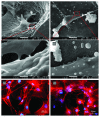Scanning Techniques for Nanobioconjugates of Carbon Nanotubes
- PMID: 30008981
- PMCID: PMC6020491
- DOI: 10.1155/2018/6254692
Scanning Techniques for Nanobioconjugates of Carbon Nanotubes
Abstract
Nanobioconjugates using carbon nanotubes (CNTs) are attractive and promising hybrid materials. Various biological applications using the CNT nanobioconjugates, for example, drug delivery systems and nanobiosensors, have been proposed by many authors. Scanning techniques such as scanning electron microscopy (SEM) and scanning probe microscopy (SPM) have advantages to characterize the CNT nanobioconjugates under various conditions, for example, isolated conjugates, conjugates in thin films, and conjugates in living cells. In this review article, almost 300 papers are categorized based on types of CNT applications, and various scanning data are introduced to illuminate merits of scanning techniques.
Figures









Similar articles
-
Probe Microscopic Studies of DNA Molecules on Carbon Nanotubes.Nanomaterials (Basel). 2016 Oct 8;6(10):180. doi: 10.3390/nano6100180. Nanomaterials (Basel). 2016. PMID: 28335308 Free PMC article. Review.
-
Carbon Nanotube Emissions from Arc Discharge Production: Classification of Particle Types with Electron Microscopy and Comparison with Direct Reading Techniques.Ann Occup Hyg. 2016 May;60(4):493-512. doi: 10.1093/annhyg/mev094. Epub 2016 Jan 8. Ann Occup Hyg. 2016. PMID: 26748380 Free PMC article.
-
Real-Time Emission and Exposure Measurements of Multi-walled Carbon Nanotubes during Production, Power Sawing, and Testing of Epoxy-Based Nanocomposites.Ann Work Expo Health. 2022 Aug 7;66(7):878-894. doi: 10.1093/annweh/wxac015. Ann Work Expo Health. 2022. PMID: 35297480 Free PMC article.
-
Binding and condensation of plasmid DNA onto functionalized carbon nanotubes: toward the construction of nanotube-based gene delivery vectors.J Am Chem Soc. 2005 Mar 30;127(12):4388-96. doi: 10.1021/ja0441561. J Am Chem Soc. 2005. PMID: 15783221
-
Carbon nanotubes for delivery of small molecule drugs.Adv Drug Deliv Rev. 2013 Dec;65(15):1964-2015. doi: 10.1016/j.addr.2013.08.005. Epub 2013 Aug 14. Adv Drug Deliv Rev. 2013. PMID: 23954402 Review.
Cited by
-
Dispersion of Carbon Nanotubes with "Green" Detergents.Molecules. 2021 May 14;26(10):2908. doi: 10.3390/molecules26102908. Molecules. 2021. PMID: 34068851 Free PMC article.
-
Stable Near-Infrared Photoluminescence of Single-Walled Carbon Nanotubes Dispersed Using a Coconut-Based Natural Detergent.ACS Omega. 2021 Nov 2;6(45):30708-30715. doi: 10.1021/acsomega.1c04615. eCollection 2021 Nov 16. ACS Omega. 2021. PMID: 34805698 Free PMC article.
References
-
- Ebbesen T. W. Carbon nanotubes. Annual Review of Materials Science. 1994;24(1):235–264. doi: 10.1146/annurev.ms.24.080194.001315. - DOI
Publication types
LinkOut - more resources
Full Text Sources
Other Literature Sources
